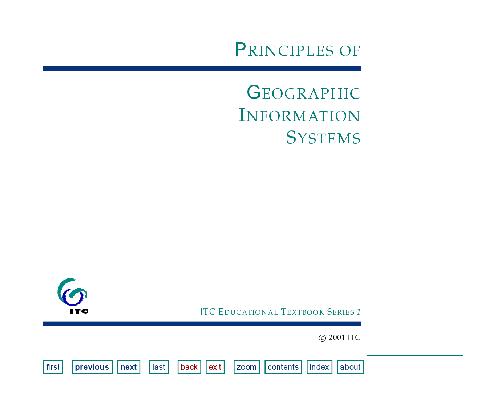de By R.A.9061642000
Table of contents :
Title page……Page 1
Table of contents……Page 4
List of figures……Page 10
List of tables……Page 16
Preface……Page 17
1 A gentle introduction to GIS……Page 26
1.1 The purpose of GIS……Page 27
1.1.1 Some fundamental observations……Page 30
1.1.2 A first definition of GIS……Page 33
1.1.3 Spatial data and geoinformation……Page 42
1.1.4 Applications of GIS……Page 43
1.2 The real world and representations of it……Page 45
1.2.1 Modelling……Page 46
1.2.2 Maps……Page 48
1.2.3 Databases……Page 49
1.2.4 Spatial databases……Page 52
1.3 An overview of upcoming chapters……Page 57
2 Geographic information and Spatial data types……Page 64
2.1 Geographic phenomena……Page 67
2.1.1 Geographic phenomenon defined……Page 68
2.1.2 Different types of geographic phenomena……Page 70
2.1.3 Geographic fields……Page 73
2.1.4 Geographic objects……Page 77
2.1.5 Boundaries……Page 81
2.2 Computer representations of geographic information……Page 82
2.2.1 Regular tessellations……Page 85
2.2.2 Irregular tessellations……Page 88
2.2.3 Vector representations……Page 90
2.2.4 Topology and spatial relationships……Page 100
2.2.5 Scale and resolution……Page 110
2.2.6 Representations of geographic fields……Page 111
2.2.7 Representation of geographic objects……Page 116
2.3 Organizing one’s spatial data……Page 121
2.4 The temporal dimension……Page 123
2.4.1 Spatiotemporal data……Page 124
2.4.2 Spatiotemporal data models……Page 128
3 Data processing systems……Page 139
3.1 Hardware and software trends……Page 141
3.2 Geographic information systems……Page 143
3.2.1 The context of GIS usage……Page 144
3.2.2 GIS software……Page 147
3.2.3 Software architecture and functionality of a GIS……Page 149
3.2.4 Querying, maintenance and spatial analysis……Page 158
3.3 Database management systems……Page 165
3.3.1 Using a DBMS……Page 167
3.3.2 Alternatives for data management……Page 170
3.3.3 The relational data model……Page 171
3.3.4 Querying a relational database……Page 180
3.3.5 Other DBMSs……Page 186
3.3.6 Using GIS and DBMS together……Page 187
4 Data entry and preparation……Page 194
4.1 Spatial data input……Page 195
4.1.1 Direct spatial data acquisition……Page 196
4.1.2 Digitizing paper maps……Page 197
4.1.3 Obtaining spatial data elsewhere……Page 205
4.2 Spatial referencing……Page 207
4.2.1 Spatial reference systems and frames……Page 208
4.2.2 Spatial reference surfaces and datums……Page 211
4.2.3 Datum transformations……Page 219
4.2.4 Map projections……Page 223
4.3 Data preparation……Page 231
4.3.1 Data checks and repairs……Page 232
4.3.2 Combining multiple data sources……Page 239
4.4 Point data transformation……Page 244
4.4.1 Generating discrete field representations from point data……Page 246
4.4.2 Generating continuous field representations from point data……Page 248
4.5 Advanced operations on continuous field rasters……Page 260
4.5.1 Applications……Page 261
4.5.2 Filtering……Page 264
4.5.3 Computation of slope angle and slope aspect……Page 266
5 Spatial data analysis……Page 276
5.1 Classification of analytic GIS capabilities……Page 278
5.2 Retrieval, classification and measurement……Page 280
5.2.1 Measurement……Page 281
5.2.2 Spatial selection queries……Page 286
5.2.3 Classification……Page 299
5.3 Overlay functions……Page 305
5.3.1 Vector overlay operators……Page 306
5.3.2 Raster overlay operators……Page 310
5.3.3 Overlays using a decision table……Page 317
5.4 Neighbourhood functions……Page 319
5.4.1 Proximity computation……Page 322
5.4.2 Spread computation……Page 327
5.4.3 Seek computation……Page 330
5.5 Network analysis……Page 332
6 Data visualization……Page 346
6.1 GIS and maps……Page 347
6.2 The visualization process……Page 357
6.3 Visualization strategies: present or explore……Page 361
6.4 The cartographic toolbox……Page 367
6.4.1 What kind of data do I have?……Page 368
6.4.2 How can I map my data?……Page 370
6.5 How to map …?……Page 372
6.5.1 How to map qualitative data……Page 373
6.5.2 How to map quantitative data……Page 375
6.5.3 How to map the terrain elevation……Page 379
6.5.4 How to map time series……Page 383
6.6 Map cosmetics……Page 386
6.7 Map output……Page 390
7 Data quality and metadata……Page 399
7.1 Basic concepts and definitions……Page 400
7.1.1 Data quality……Page 401
7.1.2 Error……Page 402
7.1.3 Accuracy and precision……Page 403
7.1.4 Attribute accuracy……Page 405
7.1.5 Temporal accuracy……Page 407
7.1.6 Lineage……Page 408
7.1.7 Completeness……Page 409
7.1.8 Logical consistency……Page 410
7.2 Measures of location error on maps……Page 412
7.2.1 Root mean square error……Page 413
7.2.2 Accuracy tolerances……Page 415
7.2.3 The epsilon band……Page 417
7.2.4 Describing natural uncertainty in spatial data……Page 419
7.3 Error propagation in spatial data processing……Page 422
7.3.1 How errors propagate……Page 423
7.3.2 Error propagation analysis……Page 425
7.4 Metadata and data sharing……Page 431
7.4.1 Data sharing and related problems……Page 432
7.4.2 Spatial data transfer and its standards……Page 438
7.4.3 Geographic information infrastructure and clearinghouses……Page 442
7.4.4 Metadata concepts and functionality……Page 444
7.4.5 Structure of metadata……Page 450
Bibliography……Page 454
A Internet sites……Page 462
Glossary……Page 466
Index……Page 484

Reviews
There are no reviews yet.